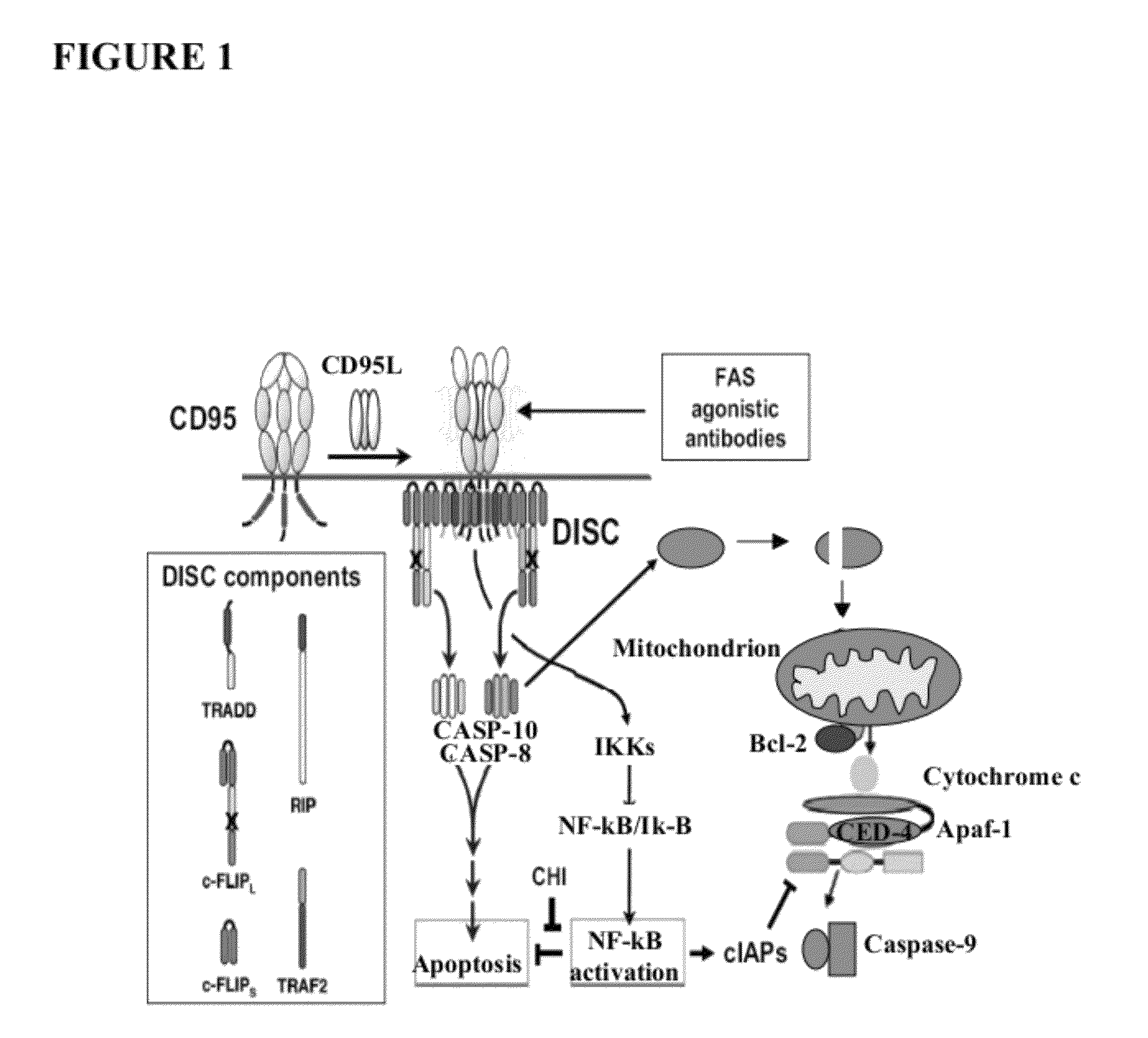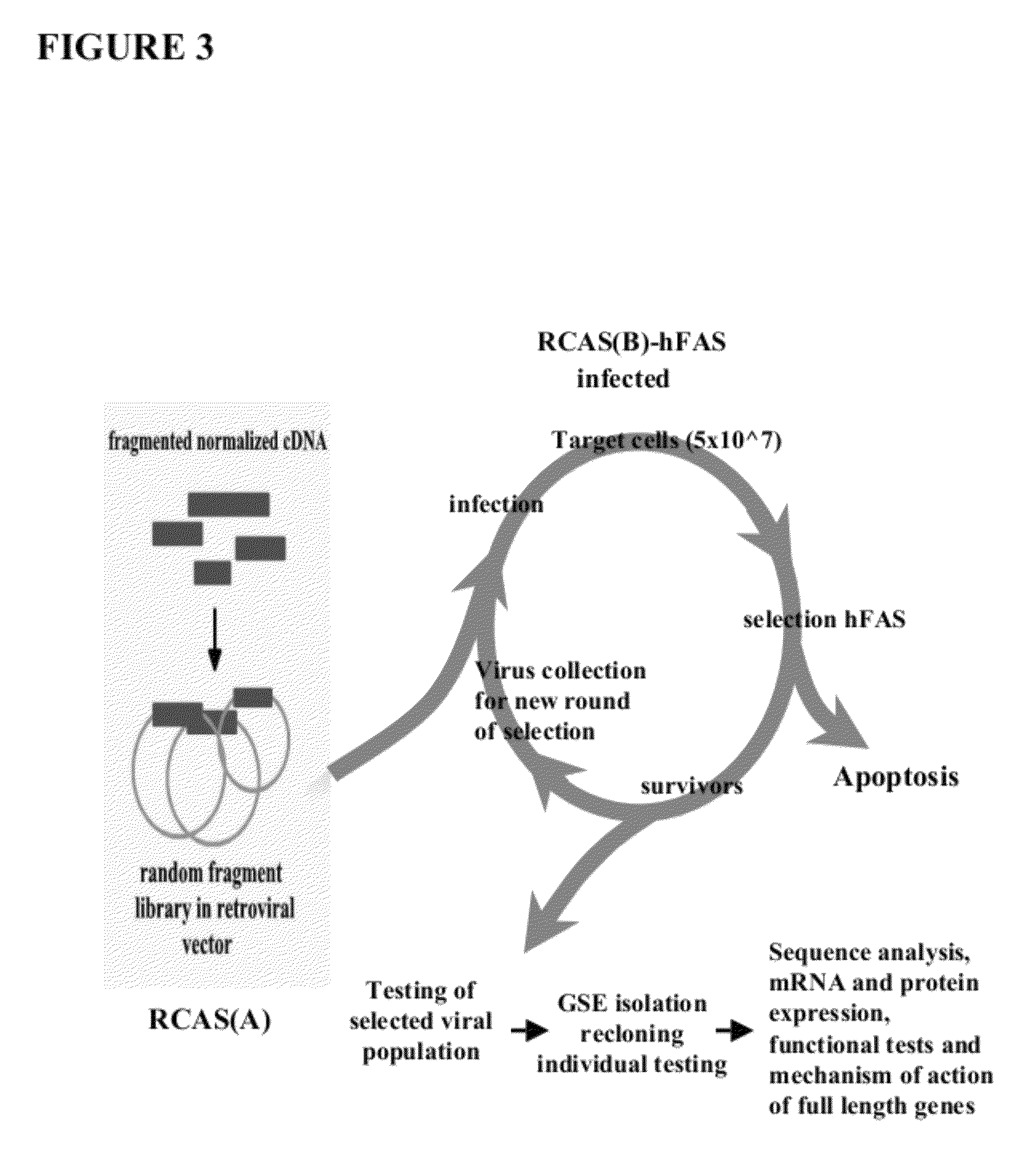Methods for identifying modulators of apoptosis
a technology of apoptosis and modulators, applied in the field of identifying modulators of apoptosis, can solve the problems of not being effective in slowing tumor growth at a fast enough rate to reduce the probability of metastasis
- Summary
- Abstract
- Description
- Claims
- Application Information
AI Technical Summary
Benefits of technology
Problems solved by technology
Method used
Image
Examples
example 1
Novel Component of FAS-Mediated Apoptosis
[0120]The following results indicate the identification of cytoplasmic cytochrome b as a component of FAS-mediated apoptosis. A genetic suppressor analysis was undertaken to identify dominantly acting peptides that inhibit FAS-dependent apoptosis. A library of random peptide fragments of multi-domain proteins was made using the replication-competent avian retroviral vector RCASBP(A). The library was overexpressed in human FAS receptor expressing cells. See FIG. 3. The cells were subjected to FAS apoptosis by treatment with a FAS agonistic antibody. The replication competency of RCAS vector allowed for several rounds of selection and screening by efficient rescue of viral particles. Virus particles from cells that did not undergo apoptosis carried RCASBP(A), which encoded peptide fragments (inserts) that inactivate FAS-dependent apoptosis. See FIG. 4. Fragments that inhibit apoptosis were then further characterized.
[0121]Total RNA from 5 indiv...
example 2
MVP Binds to Cytochrome b
[0126]The following results identify major vault protein as a counterpart of Cyt b. The following procedure was used to identify MVP as a regulator of Cyt b. FLAG-tagged Cyt b with FLAG at its C terminus was transduced by lentiviral infection into HeLa and DF-1 cells. Since cytoplasmic Cyt b was found to be toxic for these cells, cell lysates were collected 40 hours after infection when the majority of cells remained viable but apoptosis was already initiated, suggesting that newly synthesized Cyt b has reached its cytoplasmic targets. Cell lysates containing FLAG-tagged Cyt b, as well as the control mock-transduced cells lacking FLAG-tagged proteins, were collected and incubated with M2 anti-FLAG antibodies conjugated with agarose beads as described in U.S. Prov. Appl. No. 60 / 805,849. Cytoplasmic proteins coprecipitating with Cyt b-FLAG were loaded on two parallel PAA gels, one for silver staining, and the other for Western blot analysis with anti-FLAG and ...
example 3
MVP Regulates FAS Mediated Apoptosis Through Cytochrome b
[0129]The following results indicate that MVP interacts with cytochrome b and suppresses fas-mediated apoptosis. A number of constructs were generated, including a construct that overexpresses MVP alone, MVP+cyto b, and a shMVP sequence+cyto b. These vectors were transfected into Hela cells via lentiviruses and the cells were subjected to Fas-apoptosis analysis. Fas ligand was added and the number of surviving Hela cells were counted after 48 hrs. post ligand addition. EGFP served as a negative control. In FIG. 7a it is shown that Hela cells expressing only MVP survive at a 100% rate. Cells with cyto b and EGFP survived at only a rate of 30%. Cells overexpressing MVP and cyto b indicate an 82% survival. These results indicate (1) MVP has a negative effect on cyto b and its role in FAS-mediated apoptosis. In FIG. 7c, cells not induced by FAS antibody, show 100% survival in cells that overexpress either EGFP or MVP. When FAS ant...
PUM
| Property | Measurement | Unit |
|---|---|---|
| molecular weight | aaaaa | aaaaa |
| molecular weights | aaaaa | aaaaa |
| molecular weights | aaaaa | aaaaa |
Abstract
Description
Claims
Application Information
 Login to View More
Login to View More - R&D
- Intellectual Property
- Life Sciences
- Materials
- Tech Scout
- Unparalleled Data Quality
- Higher Quality Content
- 60% Fewer Hallucinations
Browse by: Latest US Patents, China's latest patents, Technical Efficacy Thesaurus, Application Domain, Technology Topic, Popular Technical Reports.
© 2025 PatSnap. All rights reserved.Legal|Privacy policy|Modern Slavery Act Transparency Statement|Sitemap|About US| Contact US: help@patsnap.com



